
Spiritual Practices
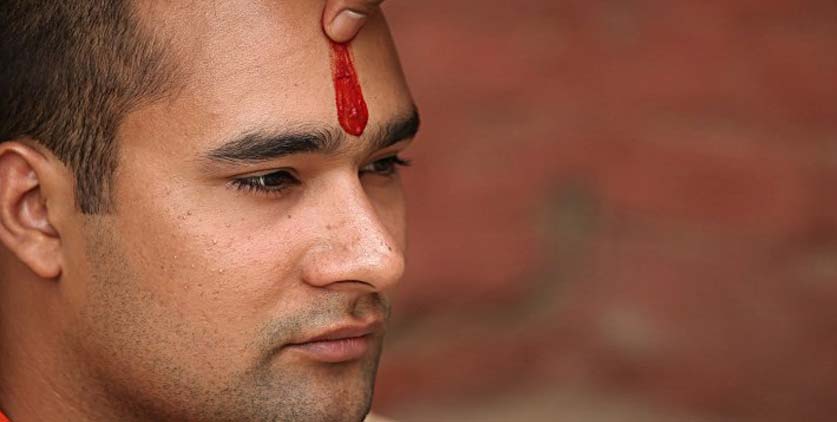
The Meaning of Tilak-Chandlo: A Symbol of Pride for Swaminarayan Youth
There’s an old Gujarati saying from nearly 200 years ago: “Tilak, topi, and toontiyu came together and will go together.” Back then, three new things entered Gujarat—
Tilak-Chandlo: A unique spiritual mark of the Swaminarayan tradition
Topi: The British-style hat
Toontiyu: The unfamiliar and deadly smallpox virus
Of the three, only one stayed—and not just stayed, but spread across the world: the tilak-chandlo. It became the visible identity of a Swaminarayan devotee, a spiritual symbol that speaks without words.
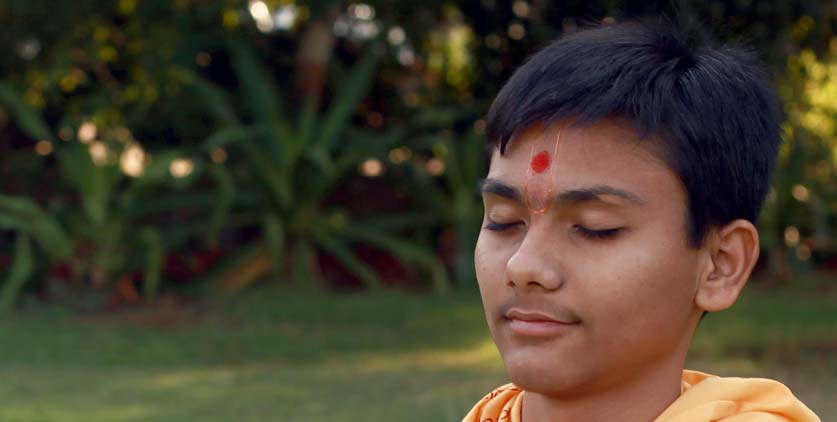
Straight from Akshardham
Bhagwan Swaminarayan Himself declared, “We brought this tilak-chandlo from Akshardham.”
It’s not just a decoration—it’s sacred.
It symbolizes trust, identity, and the ultimate guarantee of moksha.
It shows the deep connection between Bhagwan and His Anadimuktas.
Even Shriji Maharaj applied it—recorded in Vachanamrut Gadhada Madhya 14, when He applied it on the first day of Bhadarva Sud, Samvat 1878.
What Makes It Stand Out: Gurudev Bapji’s Vision
Our Guru, Gurudev Bapji , and SMVS sants apply a beautifully bold tilak-chandlo—larger than most. Once asked why, Bapji responded:
“Our God is great, our Guru is great, and our path of moksha is great— so why should our chandlo be small?”
It’s not about show. It’s about pride. It’s a way to tell the world, "I belong to Bhagwan Swaminarayan."
Real Leaders follow it
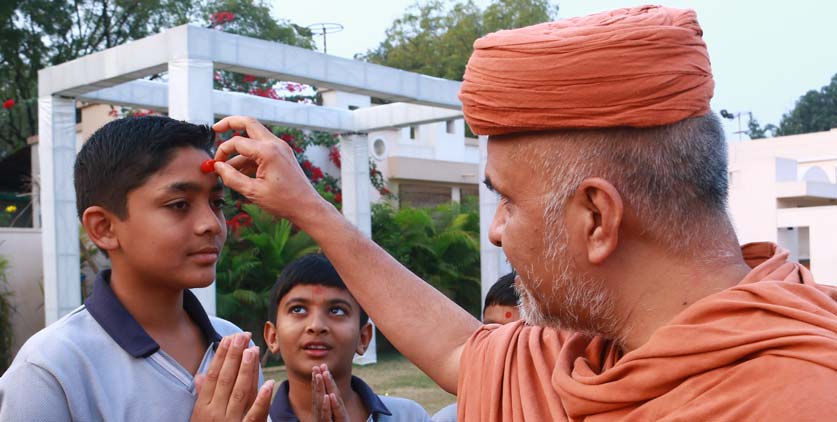
Many teens feel hesitant to have a tilak chandlo in public, fearing they’ll stand out or be judged. But the truth is, it’s not something to hide — it’s something to honor.
The tilak chandlo isn’t just a mark on your forehead; it’s a symbol of who you are and what you stand for. Just like a sports jersey or a team logo shows loyalty, this sacred symbol shows your connection to something higher — to purity, purpose, and God.
The NBA star Enes Kanter Freedom — he never hides his spiritual identity, even when it brings criticism.
George Harrison of The Beatles — one of the most famous musicians of all time — openly practiced Hinduism, had tilak, and sang bhajans in front of massive crowds. He wasn’t embarrassed. He was elevated. In a world where everyone’s trying to fit in, real courage is in standing out for the right reasons.
Former Prime Minister of India Gulzarilal Nanda (1964 and again in 1966) proudly had a Swaminarayan tilak-chandlo every day—even while in office. That’s strength. That’s faith.
The tilak chandlo is like your personal superhero emblem — reminding you to live with values, clarity, and strength. Having it doesn’t make you less cool — it makes you more rooted. And that kind of confidence? That’s rare.
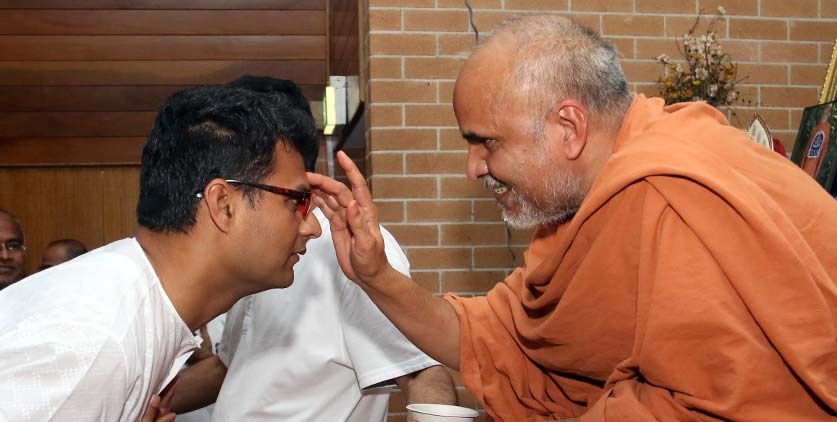
Many so-called intellectuals today argue that religion is an internal matter and does not need to be displayed publicly. While it is true that religion is an internal and personal matter, anything deeply rooted in one's soul naturally manifests outwardly. If someone has eaten garlic, its smell inevitably comes out. When one acquires something new, they usually show it off to a few people. Similarly, if one's devotion and worship are deeply ingrained, why wouldn't it be displayed? If it doesn’t, then it is hypocrisy and pretense, a sign of internal emptiness. However, not all who do the Tilak-Chandlo are internally rich in their faith. There are exceptions where individuals bring shame to our pure tradition through their poor conduct. Those who do the Tilak-Chandlo should be especially careful that their words, behavior, and actions do not disgrace our sect, our deity, or our Guru. We are different from the rest of the world. Doing the Tilak-Chandlo increases our responsibility compared to others.
Command of the Tilak-Chandlo
In the Shikshapatri, Shriji Maharaj provides detailed instructions regarding the Tilak-Chandlo in verses 41, 42, and 43. He instructs, "Men should apply sandalwood paste (Tilak) on the forehead, both arms, and chest, and make a round Kumkum Chandlo in the middle of the Tilak on the forehead. Women should only apply a Kumkum Chandlo on their forehead, while widows should not apply either Tilak or Chandlo."
Shriji Maharaj observed that the disciples of Sadguru Ramanand Swami do various religious symbols on their foreheads. There was no uniformity or decorum in these symbols. They applied different marks—some horizontal, some vertical, some with sandalwood paste, some with clay or ashes. After the departure of Ramanand Swami, Shriji Maharaj aimed to unify everyone under a single practice and provide a distinct symbol of the deity. He thus abolished these various symbols and commanded everyone to apply a vertical sandalwood paste (Tilak) with a round Kumkum Chandlo in the center (as is practiced now). Shriji Maharaj himself adorned the learned saint Nityanand Swami with the prescribed Tilak-Chandlo and instructed all followers to do the same. Since then, this tradition has been faithfully followed by all.
Many people, upon seeing our Tilak-Chandlo, comment, "This is just plain Kumkum." This is because our Chandlo is made purely from dry Kumkum. Soaked Kumkum is not permitted. Hence, Gurudev Bapji often says, "Shriji Maharaj has not even given water a chance in our Chandlo; then why give other things a chance?" This means that choghadiya, mahurats, and other such considerations should not concern Swaminarayan devotees.
The Tilak-Chandlo as a Symbol of Vishishtadvaita
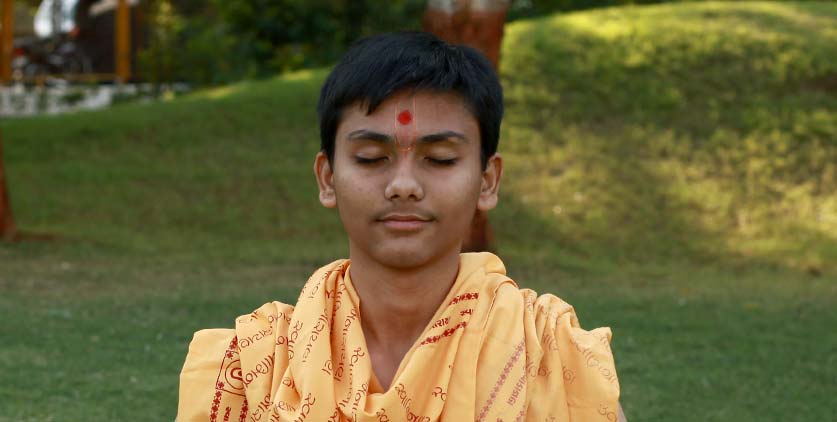
Vishishtadvaita means "qualified non-dualism," where two distinct entities appear as one. The Tilak (sandalwood paste) and Chandlo (Kumkum mark) are two separate substances. However, when combined as the Tilak-Chandlo, they present a unified appearance. Similarly, Shriji Maharaj and the liberated souls (Muktas) are two distinct entities. Yet, when the Muktas reside in the divine form, they no longer appear separate; thus, appearance is only of Shriji Maharaj himself. Thus, though there are two distinct entities, their unified appearance represents the essence of Vishishtadvaita.
The Method of Applying Tilak-Chandlo
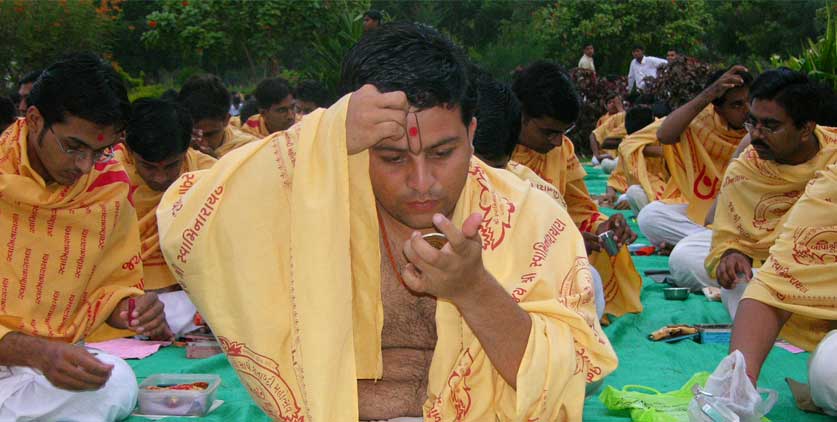
The puja-kit includes a ‘U’ shaped tool appropriately, called a "tilakyu" that aids in applying tilak. Make a thin paste by rubbing sandalwood stick and water in a stone mortar (also included in the puja-kit). Apply the paste onto the tilakyu and do tilak on the forehead, chest, and both arms. Do a sandalwood chandlo in the middle of the tilak on both arms and chest. Any round container filled with kumkum powder can be used to do the chandlo on the forehead.
To make the round kumkum mark (chandlo), a small circular container filled with kumkum can be used. The container is pressed onto the forehead to create the mark.
First, apply the kumkum chandlo on the forehead.Then, apply the tilak. The tilak represents Shriji Maharaj, and the chandlo represents the liberated souls (Muktas). Just as the chandlo resides within the tilak, the Muktas reside within Shriji Maharaj. This symbolizes the unity of Maharaj and Mukta, revealing the mystery of their eternal bond.
It's important to apply both the tilak and the chandlo correctly:
Applying only the chandlo without the tilak is not appropriate, as the chandlo symbolizes the Muktas, who cannot exist without Shriji Maharaj.Using chandan instead of kumkum for the chandlo is also incorrect. The chandlo must be made with kumkum.
The tilak-chandlo should be applied at the beginning of the daily puja, as performing puja without it is considered incomplete.
There are many scientific and social reasons as to why the tilak chandlo is done on the forehead.
Scientific reasons: The tilak is considered a symbol of a person's knowledge and intellect. Our intellect resides in the brain, which is a marvelous computer created by God. The human brain can process 100 billion instructions simultaneously. American scientists attempted to replicate this by constructing a 27-story lab filled with various machinery and employing hundreds of experts. Despite these efforts, the human brain's design remains unparalleled. Thus, worshipping this incredible brain, given to us by God, is akin to worshipping God Himself. This is why we adorn the forehead with the tilak-chandlo. Another significant reason for this practice is that the ajna chakra, located between our eyebrows, is crucial. All the activities and decisions we make throughout the day place a burden on this center. Sandalwood (chandan) is known for its calming properties. Applying sandalwood paste to the forehead helps keep this center calm and efficient. There is also a belief that our body continuously emits spiritual energy, causing the forehead area to become warm. This increased heat can potentially lead to various ailments. Applying the tilak with sandalwood helps mitigate this heat, thus preventing these issues.
Social reasons: In ancient times, a tilak – chandlo was done on the warrior's forehead as a symbol of pride when a person goes to war. When enthroning a king, a tilak ceremony is performed, where tilak is done on his forehead. When a woman finds a suitable man for herself, it is her good fortune, and as a symbol of that blessing, she applies a chandlo on her forehead.
In society, people performing specific roles often have distinct identifiers. A khaki uniform signifies a police officer, white attire is the dress code for nurses in hospitals, and a black coat is the mark of a judge. Is it mandatory for them to wear these uniforms? Does a police officer's power increase when wearing a khaki uniform? Does a nurse's sense of service grow when donning white attire? Does a judge's judicial wisdom enhance when wearing a black coat? No, it doesn't. However, at the very least, these external symbols make them aware of their responsibilities. Hence, there is a need for such external formalities. Similarly, just doing a tilak-chandlo does not automatically make one a perfect satsangi (devotee). Nonetheless, it often serves as a reminder or a check. When a devotee sees the tilak-chandlo on their forehead, it reminds them of their faith and responsibilities. It also serves as a visible marker to others, potentially reminding the wearer to uphold their values and to act in accordance with their beliefs.
When someone approaches Gurudev P.P. Bapji without a tilak-chandlo on their forehead, he immediately notices and remarks, “Why haven't you marked your forehead? A shop without a signboard doesn't attract customers. If there's a signboard, customers will come to the shop.” He might also say, “The tilak-chandlo is like a license. Without a license, the police will catch you if you go out!” He uses these analogies to emphasize the importance of wearing the tilak-chandlo and ensures that the person applies it.This practice of wearing the tilak-chandlo, therefore, is not just about the act itself, but about what it symbolizes – a commitment to one's faith, an external reminder of one's responsibilities, and a visible sign to others of their identity and values.
Upon seeing a devotee without tilak – chandlo, HDH Swamishri gave him the agya to always do tilak – chandlo from then on. The devotee responded, "Dayalu! Raji rahejo! But I will not be able to do that." Amazed HDH Swamishri asked, "Why? What is it that makes it so difficult?" The devotee innocently explained the reality; he said, "I have a bad habit of watching movies. I go to the theater at least once every week. If I do a tilak - chandlo, I have to put a halt to that, else it will be sinful, and I will not be able to stop watching movies. Therefore, please raji rahejo as I will not be able to do what You are asking of me."
HDH Swamishri replied, “Let that habit continue for now but at least start doing tilak – chandlo. It shall certainly help you, and on the bright side, it has no disadvantages. Therefore, do keep the niyam of tilak – chandlo.” The devotee could not disregard the politeness of HDH Swamishri and agreed to start doing tilak – chandlo. As a victim of his habit, the devotee went to the theater. As he lined up in the queue for his ticket, he noticed the people around him staring at his forehead. The devotee thought to himself, why is everyone staring at me? Meanwhile, someone said, "How can you watch movies with such beautiful tilak – chandlo on your forehead? You should be ashamed standing in a line for a ticket?" Embarrassment grooved on the face of the devotee; the words from the stranger hit him hard. He walked out of the theater and promised never to watch a film in his life again.
In Vadodara, a young satsangi, exceptionally brilliant in his studies, secured a position in the board exams in 1968. He regularly adorned his forehead with a beautiful tilak-chandlo. Even after securing admission in college for further studies, he continued this practice without any hesitation or embarrassment about what his peers might think.
The principal of the college, who was somewhat peculiar and held a prejudice against religious symbols, would notice this young man's tilak-chandlo every day. One day, the principal called the young satsangi into his office and said, "This is a college, not a temple. I don't like these religious marks, so don't come to college with this tilak." Hearing this stern warning, the young satsangi was not intimidated. He was not only very intelligent but also took immense pride in his faith. He confidently replied to the principal, "Sir, you are the principal of the college, not of my tilak-chandlo. Listen, I can never abandon this tilak-chandlo. If you pressurize me too much, I will leave the college, but I will never do away with my tilak-chandlo."
Hearing such a bold and fearless response, the principal was stunned and let him go without further argument. This is the pride a true satsangi holds for the tilak-chandlo given by Shriji Maharaj. In contrast, many young students do away with the tilak-chandlo during their morning prayers but wipe it off when it's time to go to college.
The construction of the Vasna mandir was in the process in 1983, and HDH Swamishri and the sants lived in a small shed. A devotee's son who had a Master of Commerce (M.Com) degree was looking for work. The age cut-off was 25 years at the moment, and those exceeding the limit would not be eligible to work for the government. He received a call for an interview to work for the Reserve bank of India. A total of 13 individuals were to be recruited, and the candidates were many. On the interview day, the son came to the Vasna temple at noon to meet HDH Swamishri. He said, "I have an interview with the Reserve Bank of India today, I have passed the written exam, and I have my in-person interview today. I have to be at the Reserve bank of India located on Ashram Road by 3:00 pm. You pray to Maharaj on my behalf. He listens to You. This is my final chance to get a government job since I will be completing 25 years. It would be impossible to find a government job after that. So, please bless me and pray on my behalf.”
HDH Swamishri said, "I surely shall pray for you, but Maharaj will not listen.” “Why will he not?” asked the son. “Because you do not abide by His agya." HDH Swamishri continued, "Do you do puja daily?" "Yes!" the son replied. "Do you do tilak – chandlo?” asked HDH Swamishri. “No,” he said. “Since you do not follow this agya, Maharaj will not listen to your prayers,” revealed HDH Swamishri. “Then dayalu, I request You to pray to Maharaj. I shall always do tilak – chandlo from tomorrow," said the son. To that, HDH Swamishri replied, "Not starting tomorrow. It would be better to start doing it from today, and best if you start right now. Come, let me do the tilak – chandlo for you, and you go to the interview with it." The son said, "Swami raji rahejo, but can we skip for today? I shall do it starting tomorrow. I have an interview today. I will be meeting with the Managers, so if You could let it be for today." HDH Swamishri replied, “The tilak – chandlo belongs to a higher authority than the one you are going to meet, and there is no one greater than him." "But I find it embarrassing, swami," said the son.
HDH Swamishri said, “You won’t see your tilak – chandlo, so why should it embarrass you? If you agree to do tilak – chandlo right now and continue to do it every day, only then will Maharaj accept My prayers. Leading a life that is in the best interest of Maharaj makes a sant happy and when a sant is pleased, so is Maharaj." The son was in real need and therefore agreed to go to the interview wearing the tilak – chandlo. Many candidates were present for the interview; he was 187th in the line. When it was his turn, he went in and saw a board of seven individuals. The most senior interviewer of all was a Swaminarayan devotee himself. He did not have a tilak – chandlo, so the son did not know, but the senior interviewer spotted the tilak – chandlo, and before the other individuals could ask questions, he asked, "What are niyam, nishchay, and paksha?" The son recognized the question was from the 61st Vachnamrut of Gadhada Madhya chapters from the Vachnamurt. He knew the answer and said, “To abide by the rules given by Maharaj is niyam, to understand that Maharaj is Sarvopari is nishchay and to stand for and with those who follow both niyam and nishchay is called paksha." Upon hearing the answer, the interviewer pulled out his kanthi and said, “I will have to keep your paksha as well, won't I?" Even with limited vacancies, the son was able to get a job. The agya may not seem significant at times, but the rajipo that it brings is boundless.
Jayeshbhai Maniyar, a devout devotee from Surendranagar, belongs to a Jain family but holds unwavering devotion to Lord Swaminarayan. His son, Khilen, is extremely intelligent and has consistently secured the first position in his college, C. U. Shah College, while pursuing a BCA course. However, despite his academic excellence, he always adorned his forehead with a tilak-chandlo, reflecting his deep faith. Throughout his four semesters, he maintained his first position in college, but in the university exams, he secured a second rank. Once, while visiting the temple with his father, he received guidance from Pujya Santos. Santos advised him, "Continue doing the tilak-chandlo regularly. Maharaj will be pleased. If Maharaj is pleased, you will excel not only in college but also in the university." Encouraged by this, he continued doing the tilak-chandlo and continued his academic pursuits with determination.
When he persisted in doing the tilak-chandlo regularly, he scored first in college and universities during 5th semester. However, when he broke this practice during his 6th semester, his performance suffered, and he ranked sixth. Realizing his mistake, he resumed doing the tilak-chandlo regularly. In his final semester, He topped both college and university exams. His consistency in doing the tilak-chandlo had paid off. This experience taught him the importance of faith and commitment to one's beliefs.
Many youths living abroad also adheres to the practice of doing tilak-chandlo despite facing challenges. In Dubai, for example, where such practices are uncommon, a civil engineer faced skepticism during a municipal corporation interview. When questioned about the tilak-chandlo, he proudly explained its significance as a symbol of his faith. Though initially rejected, he eventually secured a double-paying job after reinstating his practice of doing the tilak-chandlo.
The courage and conviction displayed by these individuals, who refuse to compromise on their faith, greatly please Maharaj.